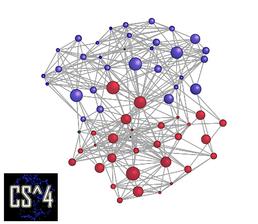Seminar 18th March 2011 4 p.m. University of Southampton, Building 58 (Social Sciences), Room 1007
Social Networks and Collective Motion in Animals
Dr Daniel Franks
University of York, Centre for Complex Systems Analysis
- Web page
- http://www-users.york.ac.uk/~df525/
- Categories
- Complex Systems, Social Networks
- Submitter
- Petrina Butler
Complex Systems Simulation Seminar Series (CS^4)
from the Institute for Complex Systems Simulation, the Complexity in Real-World Contexts USRG and the Computational Modelling Group.
Abstract
Collective motion is the term used to describe the synchronized motion of groups of animals such as shoals of fish or flocks of birds that appear to behave as one body, continually changing shape and direction. Many group-living animals show social preferences for relatives, familiar conspecifics or individuals of similar attributes such as size, personality, or sex. Such preferences can be represented as social networks. The theory of collective motion and the study of animal social networks have, each individually, received much attention. Currently, however, most models of collective motion do not consider social network structure. The implications for considering collective motion and social networks together are likely to be important. Social networks could determine how populations move in, split up into and form separate groups. Conversely, collective movement could change the structure of social networks by creating social ties that did not exist previously and maintaining existing ties. I will discuss animal social networks, and models of collective animal motion, before presenting a general model that combines the two. Counter-intuitive results from conceptual examples will show that social structures can result in unexpected group dynamics. This sharpens our understanding of the way in which collective movement can be interpreted as a result of social interactions, and provides a framework for understanding how to collect social network data and analyse the structure of animal groups. Combining social networks with collective movement also presents possibilities for improving the performance of swarm robots, and for exploring building evacuation efficiency more effectively.
Friday, 18 March 2011 - Building 58 (Social Sciences) Room 1007
3:30pm Tea and coffee
4pm Lecture
Complex Systems Simulation Seminar Series
For the complete CS^4 schedule please click here: http://www.multidisciplinary.soton.ac.uk/cs4.html
Contact
Multidisciplinary Research Co-ordinator
University Strategic Research Groups
Research and Innovation Services
02380 593244
